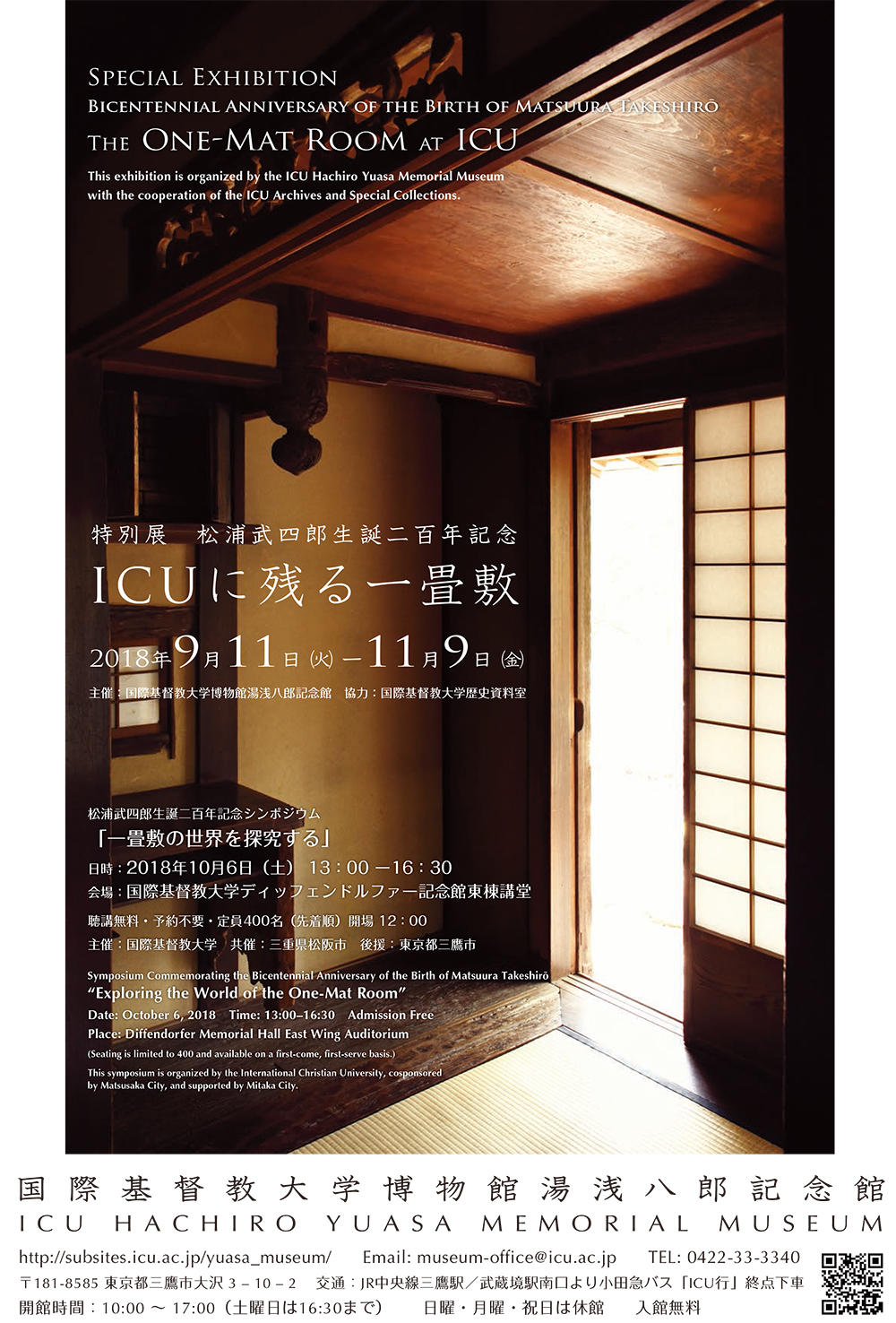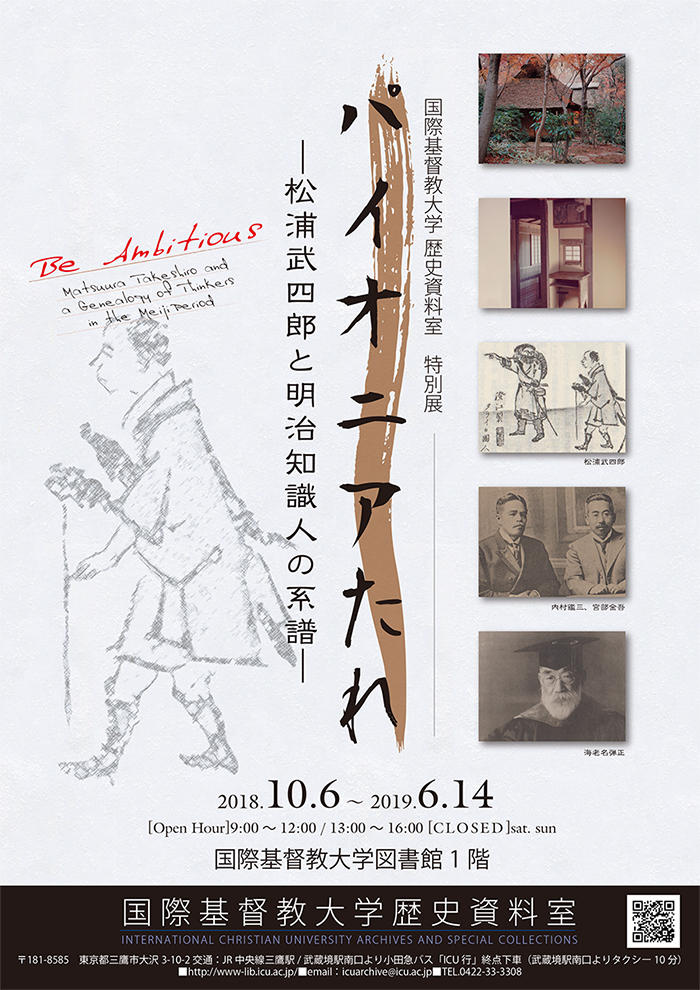Bicentennial Anniversary of the Birth of Matsuura Takeshiro

Please join in working to conserve and restore the Taizanso complex, one of Japan's registered cultural heritage sites.
With great awareness of the Taizanso's historic value, ICU has been working to properly maintain the site. In 2003 ICU students started the "Taizanso Project," which works to repair the site's badly damaged thatched roof. Students also work to clean the site, open it to the public, use it to practice the Japan tea ceremony, and research the building for a class in museum sciences, all together efforts to steadily both preserve the building and make it open for public enjoyment. Also starting from 2003, ICU implemented a restoration plan and the site's Kofukyo building, machiai teahouse, front gate and shoin style drawing room were each restored one at a time. Recent restoration work was carried out on the shoin and the stairs and railings leading to the Kofukyo.
To help restore the Taizanso, please visit our page on how to give.
Taizanso Conservation and Restoration Fund
1.Special Exhibition "The One-Mat Room at ICU"
The One-Mat Room is a unique construction resting quietly in a richly wooded section of the campus of International Christian University. As its name suggests, it is a small room consisting of just one mat surrounded by a wooden border. Complete with tokonoma alcove, kamidana (Shinto altar shelf), and a built-in bookcase, the room was built as a lean-to structure one hundred and thirty years ago.
The owner of the room was Matsuura Takeshirō (1818-1888). From his youth, he travelled enthusiastically all over Japan, especially Japan's far north, and he is known to have left many important records, including documents on Hokkaido. His geographic expertise led him to official employment by the Edo shogunate and later by the Meiji government, but he soon quit and turned to collecting antiquities, enjoying his latter days in his home in the Kanda district of Tokyo. The One-Mat Room was a private study designed to celebrate Takeshirō's upcoming seventieth year, constructed with old pieces of wood from famous temples and shrines, solicited from friends whom he had met during his travels. Although small in terms of size, it embraces a spectacular span of time and place. And it was in this room that Takeshirō spent his last days reminiscing on the past and of the people he met during his travels.

Contrary to Takeshirō's will which called for the dismantling of the One-Mat Room upon his death, it was preserved in Kanda. Its ownership changed from one person to another, its location moving three times, from Kanda to Azabu, then to Yoyogi-Uehara and finally to Mitaka in the 1930s. Miraculously surviving the vicissitudes of the Great Kantō Earthquake and Tokyo Air Raids, ICU became its final owner when the land was acquired for the university campus after World War II. Ever since, ICU has carefully preserved the One-Mat Room together with other buildings that comprise Taizansō, and they were designated as Tangible Cultural Properties in 1999.
Commemorating the bicentennial anniversary of the birth of Matsuura Takeshirō, we will explore the history and cultural elements of the One-Mat Room through this exhibition. We hope that it will help contribute to the wider recognition of the One-Mat Room as cultural heritage, leading to further understanding and cooperation toward ICU's efforts in its preservation.
| Date and time | Sep. 11 (Tue.) ー Nov.9 (Fri.) |
|---|---|
| Hours | Tue-Fri 10:00-17:00, Sat 10:00-16:30 |
| Closed | Sun, Mon, national holidays |
| Participation fee | Admission free |
| Organization | ICU HACHIRO YUASA MEMORIAL MUSEUM |
2. Symposium "Exploring the World of the One-Mat Room"
| Date | October 6, 2018 (Sat) 13:00~16:30(Open 12:00) |
|---|---|
| Location | Diffendorfer Memorial Hall East Wing(Auditorium) |
| Organization | organized by the International Christian University, cosponsored by Matsusaka City, and supported by Mitaka City |
| Application process, Participation fee | No appointment necessary, Admission free |
| Language | Japanese |
3. Be Ambitious - Matsuura Takeshiro and a Genealogy of Thinkers in the Meiji Period
The year 2018 marks a milestone for 19th-century explorer and author Takeshiro Matsuura, falling on the 200th anniversary of his birth and the 130th anniversary of his death. He was active from the closing days of the Tokugawa shogunate to the Meiji era (1868-1912) and is also known as a godparent of Hokkaido. His great accomplishments cover such a broad range of fields that they cannot be expressed in a word or two. Takeshiro spent more than eight years to build a study room, dubbed "Ichijo-jiki" or a room just the size of "ichi jo" or one tatami mat, based on time-honored pieces of wood collected through the good offices of people he got acquainted with during his journey. Within the one-mat room of minuscule space extends a microcosm where the thoughts of Takeshiro, who greeted his celebratory age of 70 then, and of his friends appeared to be amassed. Why was it the size of one mat? To find answers to this and other questions, please visit the "Ichijo-jiki left in ICU" exhibition being held in the Hachiro Yuasa Memorial Museum simultaneously with this exhibition. At the special exhibition of the ICU Archives , we will trace the track record of Christian intellectuals who led to the opening of the ICU, beginning with Takeshiro in connection with the reason why "Ichijo-jiki" is in this school, a Christian university established after the end of World War II.

In the Meiji era, Christian groups which constituted mainstream Protestant missionary work in Japan were called the Yokohama Band, Kumamoto Band and Sapporo Band according to the names of relevant places. In particular, botanist Kingo Miyabe, known as a leading figure of the Sapporo Band, had close ties with Takeshiro. Miyabe sought to study botany under the influence of Takeshiro. Kanzo Uchimura, who was among the second group of students enrolled at Sapporo Agricultural College as was Miyabe, played a leading role in the Sapporo Band to become a figure never to be forgotten in tracing the history of Christians in Japan.
The special exhibition takes up a wide range of exchanges among Christian intellectuals in the Sapporo and Kumamoto bands, overlapping Takeshiro's great achievements over the pioneering spirit as seen from that. By assuming the ICU as something down the stream of history of what has been taken over from such a human network, we hope to offer an opportunity for considering the pioneering spirit that underlies this university.
In the Meiji era, some people loudly called for "frontier development" in a condescending, pushy manner seeking to develop something obscure. Against that background, Takeshiro advised the government to pay close attention to the native people of "Ezochi," as Hokkaido was called then. Such a humble attitude as his provides us with a good opportunity to consider "what a true pioneer is" and "what the ICU's pioneer spirit is" when we live in an increasingly globalizing contemporary world.
| Date | Oct. 6, 2018 (Sat)~Jun. 14, 2019 (Fri) |
|---|---|
| Hours | Mon-Fri 9:00~16:00(Closed 12:00-13:00) , 9:00~12:00、13:00~16:30 on Oct. 6, 2018 |
| Closed | Sat, Sun, national holidays |
| Participation fee | Admission free |
| Organization | INTERNATIONAL CHRISTIAN UNIVERSITY ARCHIVES AND SPECIAL COLLECTIONS |
